Street food does not have a good reputation among the health conscious, to begin with, thus if hazardous packaging is added to the mix it might become difficult for the street vendors to run their businesses. Unsustainable packaging is not only harmful to people but also to the environment that can clog drains, accumulate waste and even release harmful toxins if not disposed of properly.
Although street food might appear tempting, the packaging can really be a turn-off sometimes. While some might present a messy package, others might provide packaging made from harmful materials. Therefore it is important to use eco-friendly and sustainable packaging even for street foods. This is where YoonPak rules with the best street food packaging ideas to solve the issue of harmful packaging.
Types Of Street Food Packaging
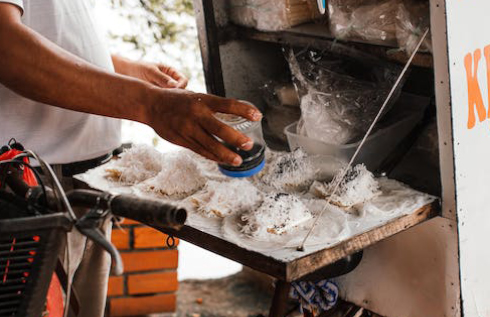
Street food packaging comes in all shapes and sizes and varies all across the globe.
Paper Cups
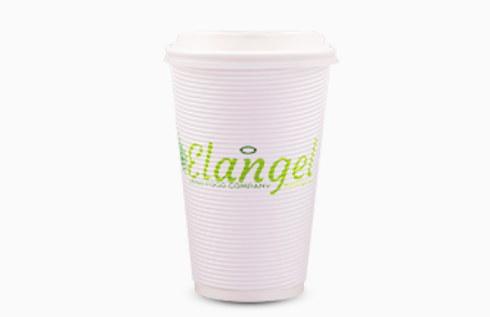
Paper cups became more common at the turn of the 20th century when people realized that using a tin or ladle to drink from a water barrel also meant spreading germs.
Since then, the paper cup has changed from being just a health remedy to a commonplace convenience item as street food containers. Millions of paper cups are used every day to allow individuals to carry their drinks with them wherever they go, which is essential in today’s busy environment.
Due to the fact that they can simply be recycled at the end of the day rather than thousands of cups needing to be washed, paper cups are another excellent choice for usage at big events like festivals and concerts.
Features And Benefits:
- These cups are constructed of paper, a material that can be thrown away. As a result, it breaks down quickly. Paper recycling is a simple process. Additionally, the cups may be more readily crumpled better than plastic cups. And this helps it to be more compact and eco-friendly.
- Paper cups can be recycled. The paper combined with water creates a pulp. New cups can be made from this pulp in the future.
- Due to their biodegradable nature, disposable paper cups are the most environmentally friendly goods. Paper is often free of harmful materials because it is derived from trees.
- There are many different sizes and forms of paper cups. These cups come in a variety of styles as well.
Applications:
- Most street vendors provide hot beverages including coffee, tea, and hot chocolate in their paper cups. Hot drinks are typically served in paper cups.
- Vendors might also offer cold beverages like juice, water, and soft drinks in printed paper cups. When it comes to cold beverages, paper thickness is not all that significant because the cup does not need to retain heat.
- Single wall cups are an inexpensive choice for pouring drinks and provide a straightforward yet clear expression on the outside.
Paper Box
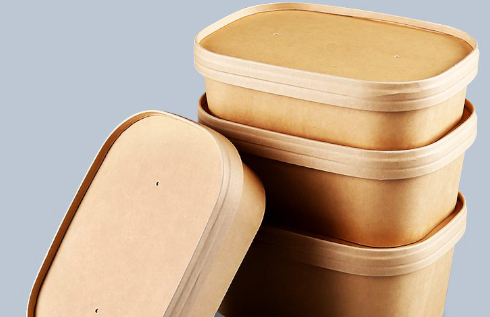
Due to its high permeability and inability to be heat-sealed, paper boxes are used to temporarily confine and safeguard food. Wax, resin, and lacquer are used as coatings and laminates when the paper is used as primary packaging for street food to improve the paper’s protective and practical qualities.
Features And Benefits:
- Paper and paperboard, which are both renewable resources, are used to make paper box containers, which have clear environmental sustainability qualities.
- Consumers clearly prefer paper and cardboard when choosing a product based on its packaging. When paper is used for street food box packaging, it makes a product appear more appealing to two-thirds of consumers than other types of packaging.
Options:
- Kraft paper, the sturdiest type of paper, is used to package dry fruits, flour, and sugar.
- Sulfite paper is used to wrap biscuits and sweets since it is significantly weaker and lighter.
- Greaseproof paper and Glassine both have tightly packed cellulose fibers that increase the paper’s ability to resist oil, making them excellent for packaging snacks, biscuits, fast food, and fatty items. Glassine also has additional moisture added to it.
- Paper that has been acid-treated, such as parchment, becomes impenetrable to liquids but not to air and vapor. Butter and lard are packaged with it.
Paper Tray
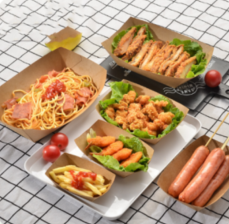
Paper food trays can be recycled and composted. It is for this reason that kraft paper, which is brown in color, bleached paper, bamboo paper, or bagasse paper manufactured from sugar cane waste with a bio-based coating are all used for this purpose.
With a compostable, recyclable paper bottom and a recyclable PET plastic transparent top, many can even be used as packaging for delis and restaurants, offering a better sustainable package and a better end for the environment.
The food trays can be used by food trucks, cafes, and kiosks to serve customers appetizers and snacks. People frequently eat while on the move. It is simple to grasp and eat off the paper trays.
Features And Benefits:
- Compared to reusable lunch boxes and plates, paper trays with lids offer greater sanitation qualities, which is one of its main advantages. A disposable plate can be thrown away after one usage. This implies that there is a considerably lower likelihood of food-borne illness with them.
- Using disposable food trays also eliminates the need for water to clean them after each use. Thus it also saves water resources.
- These items are really useful and can enable consumers to prepare food and consume it without suffering any negative consequences. Because the plates and food trays are constructed of biodegradable materials, they can be recycled and reused in the future.
Applications:
- French fries and other hot foods are served on paper trays.
- They can also be used to serve cold salads as well as some quick, crunchy nibbles like nachos and chips.
- They are typically used for food that will be consumed immediately because this kind of packaging cannot be used to serve liquids and is not designed to store food for an extended period of time.
Paper Bag
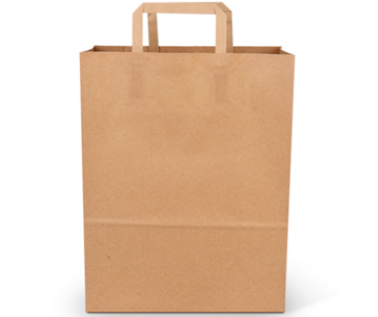
In the fast food industry, paper bags make for an effective packaging solution. Choosing the right paper bags will provide efficient packing and a consistent stream of customers to businesses.
For all types of food and beverages, these bags are available in a variety of styles and sizes. Paper bags can be personalized to increase store awareness and are both economical and environmentally friendly.
Features And Benefits:
- Paper bags are a practical way for consumers to take their goods from a fast food joint home.
- In addition to being more resilient and long-lasting than plastic bags, paper bags are also much less expensive to produce.
- Smart business owners will select environmentally friendly packaging. Fortunately, Kraft paper pulp and renewable wood are used to make paper bags. The bags are also durable enough to be reused, reducing the likelihood that they will end up in landfills or become unsightly. Customers will swarm to the store if it appears prepared to reduce its carbon footprint.
Applications:
- For carrying products like French fries, fried chips, popcorn, and other culinary snacks, paper bags work best.
- These are available in a cone- or rectangle-shaped design that can be customized to appeal to clients.
- Cafes can provide their patrons with high-quality paper bags to transport their freshly made hot dogs. Some people favor concealing their drink completely when carrying it. Paper bags that are specifically made to fit the bottle’s height come in pretty handy. For transporting wine bottles and other alcoholic beverages, paper bottle bags have a luxurious look.
Paper Bowl
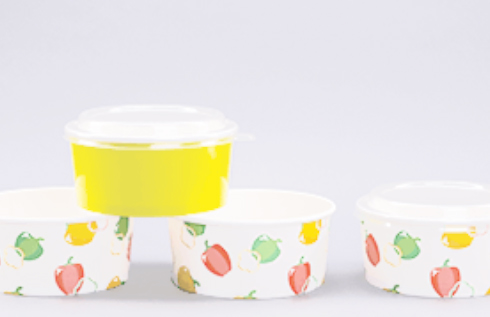
Disposable paper bowls are an excellent alternative to plastic bowls because they are constructed of FSC-certified paperboard and are completely recyclable. The paper bowls are quite adaptable and may be used for a variety of takeaway foods, whether they are hot or cold. Some paper bowls come with covers and can be used in the microwave.
Features And Benefits:
- With the addition of the recycling principle, the disposable paper bowl gains the designation of being an actual environmental protection product.
- Due to the exact manufacturing technique of moulds, sealed and disposable paper bowls have unmatched benefits over other comparable goods in food refrigeration, quick food packaging, and take-out.
- The disposable paper bowl has a microwave function since some PP materials withstand high temperatures well, making it possible to reheat food and fast food and providing consumers with a tonne of convenience.
- Due to its many uses, the disposable paper bowl has the potential to be reused, which alters consumers’ usage patterns for other comparable products.
Applications:
- Paper bowls are great for presenting delicacies like biryani, cakes, or ice cream that can easily melt.
- Premium quality bowls can keep the curry item warm for extended periods of time and are an excellent substitute for those unhealthy plastic containers.
- These appealing paper bowls are lightweight, temperature resistant, and simply disposed of after use.
Paper vs Plastic For Street Food Packaging
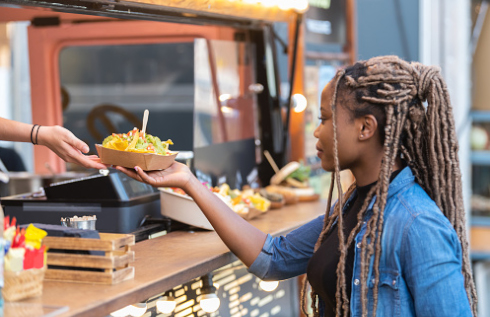
Fossil fuels, which are obviously a non-renewable source, are used to make plastics. Since feedstock for the production of plastics accounts for an estimated 4% of global oil production, plastic is seen as a poor material in terms of sustainability and renewable resources.
The issue is that because plastic offers so many benefits in modern life, it might be impossible to totally eliminate it. Plastics do not break or decay readily and can resist falls or minor injuries without suffering any damage, making them an excellent kind of protection.
Transporting goods is made simpler because plastic packing frequently does not get damaged when piled on top of one another. When compared to alternatives like glass and wood, the majority of plastic materials weigh virtually nothing, which is great for minimizing the carbon footprint when carrying goods that are wrapped with plastics.
Although plastics may offer a number of simple benefits to organizations, this does not mean that the disadvantages should be ignored. Additionally, the making of plastic pollutes the environment by releasing too much carbon dioxide into the atmosphere.
Despite the fact that plastic may be recycled, approximately 91% of the plastic that is currently in use worldwide has reportedly never been done so. When it is not recycled, it might take thousands of years to completely decay, which is hazardous to the environment.
Animals can suffocate on plastic, which also pollutes the land and oceans. Long-term exposure to sunshine breaks down the plastic molecules, poisoning the soil and reducing the fertility of the land. Microplastic residues may also linger after plastic eventually degrades, which is similarly harmful to the environment.
Due to its reputation for being environmentally benign, paper and paperboard-based packaging are among the oldest and most widely used for food products such as milk and milk-based products, beverages, dry powders, etc.
The creation of paper involves the incorporation of numerous harmful chemicals, including printing inks, phthalates, surfactants, bleaching agents, hydrocarbons, etc., which leak into the food chain during paper manufacture, food intake, and recycling through water discharges.
Recycling is regarded as the best solution for restoring environmental damage, however, paper can only be recycled six to seven times and the waste generated by the paper sector is quite diverse in both type and composition.
To be more environmentally friendly, several businesses are converting to paper street food packagingfrom plastic packaging. But using paper instead has its own environmental drawbacks.
For instance, the production of cardboard uses a lot of water, produces emissions, and, if it is not obtained responsibly, may contribute to deforestation. Additionally, recycling is challenging if it has been polluted by food or other refuse.
Disposable Cutlery And Packaging For Street Food Business
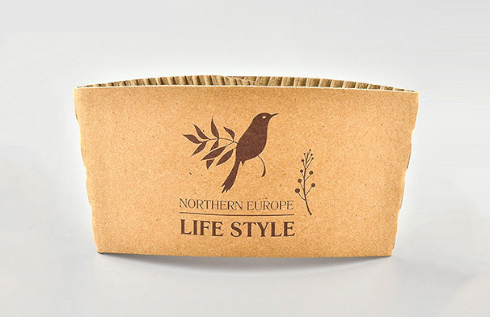
Materials
Disposable items such as fast food containers, kiosks for takeout, and catering facilities frequently use disposable food packaging. Both parties and picnics use comparable food serving utensils.
Foam street food containers, plates, bowls, cups, utensils, doilies, and tray papers are examples of typical disposable food service products. Numerous materials, including plastics, paper, bio-resins, wood, and bamboo, can be used to create these products.
Fast food and takeout food packaging generate a substantial amount of waste that is disposed of in landfills, recycled materials, compost, or as litter.
Benefits
- Disposable tableware is used for takeout service and to serve meals and beverages. The fact that the utensils are thrown away once the customer has completed eating makes this a hygienic and secure method of preventing the spread of the virus. Thus, in the face of health warnings, disposable cups and plates have emerged as the key to providing quick and, most importantly, safe and dependable service.
- A large amount of money on cleaning supplies can be saved when disposable tableware is used, in addition to saving a lot of electricity and water. It would further save much time and energy. Furthermore, when revamping the fast food business it is important to adapt to new circumstances and reorganize the personnel.
- The materials used, the shapes of the plates and cups, and even the color of the items must all match the restaurant’s atmosphere, food, and guiding principles. It will be easier to be able to build a stronger brand image this way, and the consumers will remember the brand for the same. Due to the range of designs it offers, disposable tableware can be a fantastic ally in this situation.
Street Food Packaging Design Tips
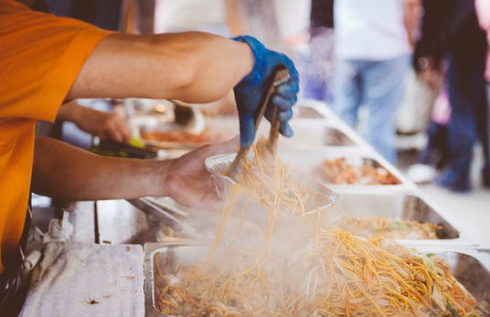
Street food packaging design needs to offer something distinctive to fully appeal to consumers, much like aesthetic appeal does, albeit distinctiveness can take many forms. Although the product’s packaging must pull customers in from the shelf, once they are there, it must keep their interest.
When competitors use conventional square boxes, unique structures are extremely effective at grabbing attention. Changing the whole package’s size can have the same result. In addition to structural adjustments, press effects and texture modifications bring something special that customers will want to interact with. Achieving this goal is made easier by soft-touch coatings, specific substrates, embossing, or debossing.
- Although distinctiveness and visual appeal are essential components of a good packaging design, it’s also critical that the packaging for street food has a high level of functionality and efficacy.
- The customer-friendly packaging of food should be the top priority. Consider items that are simple to grip, move, prevent food spills, and can be recycled after use.
- Visuals alone do not make a packaging design truly effective. An efficient design is one that boosts sales at the store and integrates nicely with the manufacturing and distribution systems.
Every brand manager, marketing manager, packaging engineer, and packaging procurement manager is also interested in effective packaging. Even for the most seasoned businesses, finding the ideal balance between appeal, distinctiveness, and effectiveness may be difficult. It is significant to push the boundaries of innovative packaging design by working with an authentic packaging supplier.
Inspiring Street Food Packaging Design Ideas
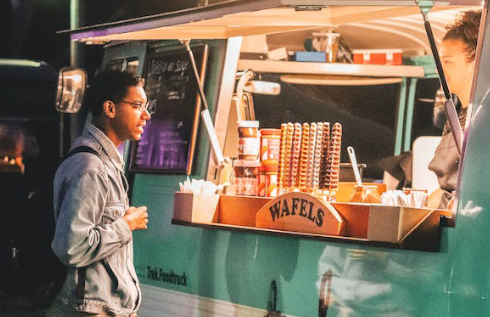
Food Boxes
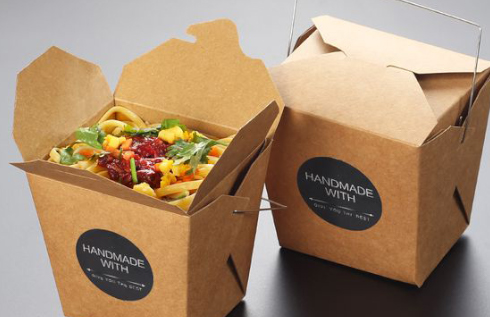
Food box packaging includes both shrink and space packaging, as well as other shapes of packaging such as jar canning, aluminum cans, and other types of defending packages such as egg cartons and milk jugs. Best if you want to service some quick munchies to the customers.
Pasta Cones
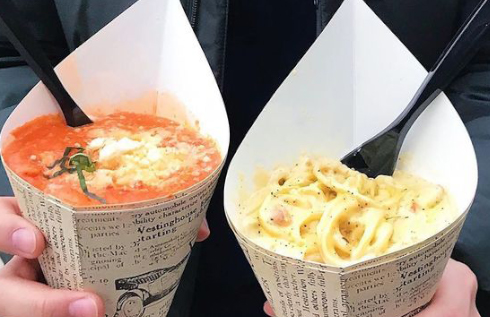
Serve the delicious pasta or noodles in a fun and innovative manner bu using custom cones with your brand name.
Bento Boxes
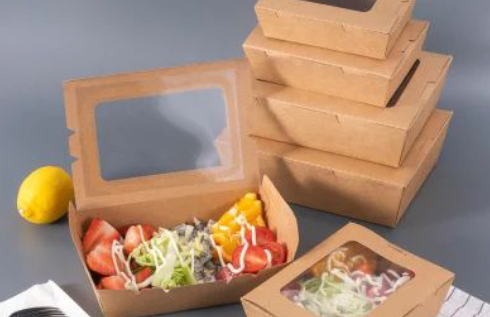
Nothing screams of streetside food packaging more than the bento boxes. Get as many bento boxes as you can for the food packaging. Use it for chips, pasta, pastries, and everything else!
Customizable Boxes
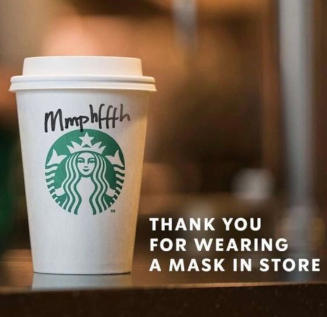
Creative custom boxes can help you stand out and provide your customers with a memorable experience. It also allows you to personalize the customer experience, which improves the customer’s opinion of your restaurant.
For example, if you know a customer who has children, you could use a food container with cartoon stickers. You could even consider turning the box into a collectible item with different designs. Alternatively, you can write the customers’ names to add a personal touch to each order.
Fun Packaging
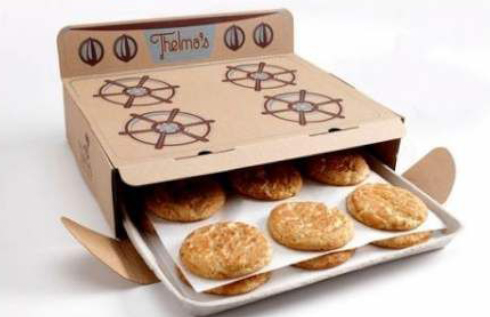
The best food delivery service ensures that the dish arrives safely and with a fun twist. It also provides an excellent opportunity for restaurant branding.
Fun packaging could include anything from humorous quotes on the packet to bright colors. However, ensure that it clearly shows what the content is and that it is handled with care.
Minimalist Packaging
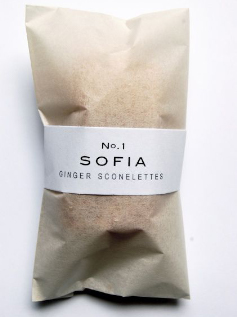
In the food packaging industry, minimalism has become a huge trend. It entails keeping the packaging simple by using straightforward labeling.
Remove branded materials and instead focus on providing value. This will make your packaging appear neat and tidy. And because you won’t be using as much ink, it will have a positive impact on the environment.
Highlight Your Brand Logo
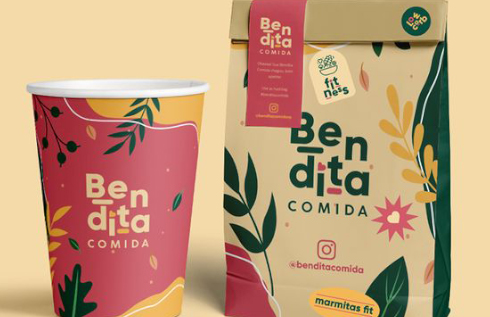
Simply put emphasis on your brand’s logo, and rest keep all the things simple and sober. Let your brand shine with each and every piece of food item that you sell.
Find A Trusted Food Packaging Supplier
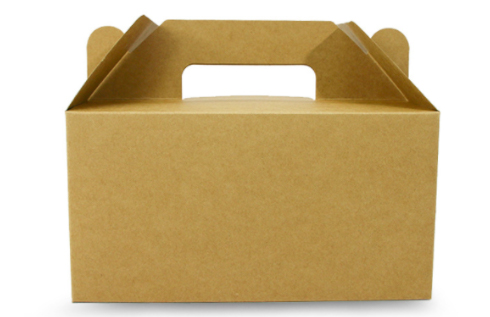
YoonPak
Yoonpak offers the most cutting-edge, environmentally friendly food packaging available. The takeout package is made completely of sustainably sourced recyclable materials and has no net carbon emissions. YoonPak makes it easy to choose the ideal street food containers for any store, whether it be kraft brown boxes that are suited for any eatery or take-out boxes with printed text.
Alibaba
Alibaba offers a large selection of products that can be used for the business or for bulk personal use when the business requires street food packaging supplies. These enthusiastic and prepared international wholesalers offer a wide variety of food packaging boxes and supplies. These goods are environmentally friendly, stylish, adaptable, and reasonably priced. Different paper and card weights, a wide range of colors and textures, boxes with and without plastic inserts, folding and collapsing boxes, and many more options are available.
Packaging Trade Shows
A trade show for the packaging sector is a gathering where participants can show off, demonstrate, and talk about their most recent goods and services. Major trade shows typically span several days and are held at convention centers in bigger cities. Local trade exhibitions give businesses in the area a chance to network with potential customers and may be staged at a nearby hotel or arena.
Conclusion
Street food packaging does play a crucial influence on a customer’s pleasure, even if it is unlikely that a consumer will prioritize packaging when deciding where to place their purchase. Customers’ happiness with their meals can be increased by packaging that puts safety, quality, and sustainability in that order. It’s crucial to use sturdy packaging that can hold up while transporting sauces, grease/oil, and other ingredients in addition to keeping foods separate.
Contact YoonPak now for all your food packaging needs.







